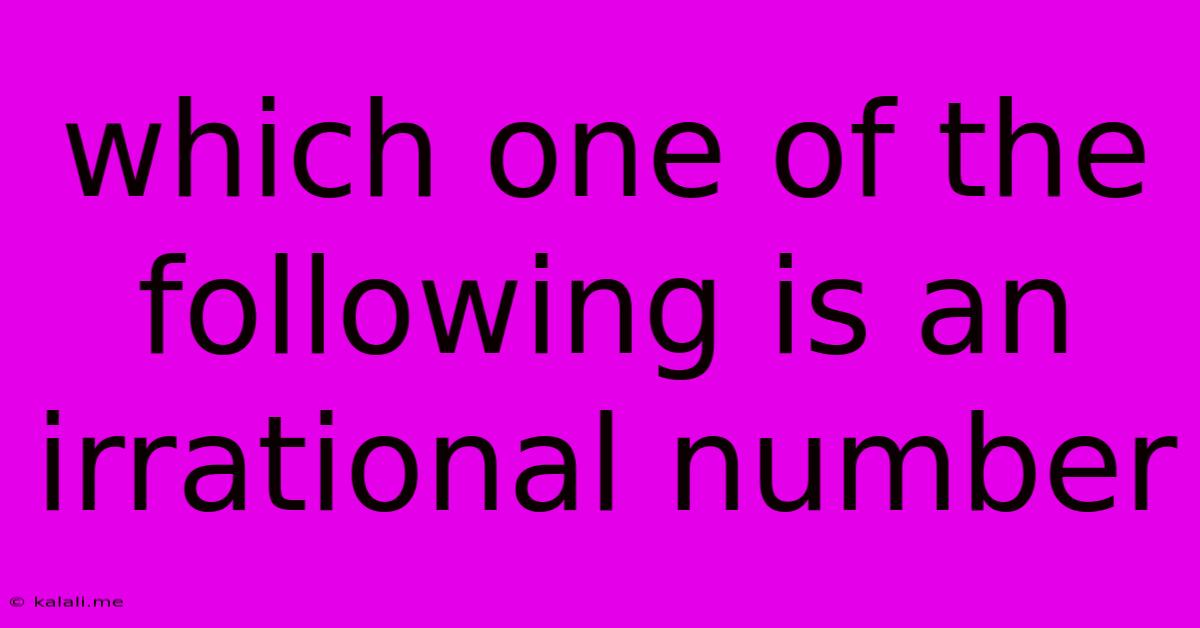Which One Of The Following Is An Irrational Number
Kalali
Jun 15, 2025 · 3 min read

Table of Contents
Which One of the Following is an Irrational Number? Understanding Irrational Numbers
This article will delve into the fascinating world of irrational numbers, explaining what they are and how to identify them. We'll tackle the question: "Which one of the following is an irrational number?" by defining irrational numbers and then exploring examples to solidify your understanding. This guide is perfect for anyone looking to brush up on their math skills or learn more about this specific type of number.
What are Irrational Numbers?
Irrational numbers are real numbers that cannot be expressed as a simple fraction, i.e., a ratio of two integers (where the denominator is not zero). This means they cannot be written as a terminating decimal (like 0.25) or a repeating decimal (like 0.333...). Instead, their decimal representation goes on forever without repeating. This non-repeating, non-terminating nature is the defining characteristic of irrational numbers.
Examples of Irrational Numbers:
The most famous irrational number is π (pi), approximately equal to 3.14159. The digits of pi continue infinitely without any repeating pattern. Other notable irrational numbers include:
- √2 (the square root of 2): This number represents the length of the diagonal of a square with sides of length 1. It cannot be expressed as a fraction of two integers.
- √3 (the square root of 3): Similar to √2, this number is also irrational.
- e (Euler's number): This important mathematical constant is approximately 2.71828. Like π, its decimal expansion continues infinitely without repeating.
- The Golden Ratio (φ): Approximately 1.618, this number appears frequently in nature and art.
Identifying Irrational Numbers:
To determine if a number is irrational, you can consider the following:
- Can it be expressed as a fraction of two integers? If yes, it's rational. If no, it's likely irrational (although proving irrationality rigorously can sometimes be challenging).
- Does its decimal representation terminate or repeat? If it terminates or repeats, it's rational. If it goes on forever without repeating, it's irrational.
Let's look at an example:
Suppose we are presented with a multiple-choice question:
Which of the following is an irrational number?
a) 0.5 b) 2/3 c) √5 d) 1.75
Let's analyze each option:
- a) 0.5: This is a terminating decimal and can be expressed as 1/2, making it a rational number.
- b) 2/3: This is a fraction and its decimal representation (0.666...) is repeating, making it a rational number.
- c) √5: The square root of 5 is a non-terminating, non-repeating decimal, thus it's an irrational number.
- d) 1.75: This is a terminating decimal and can be expressed as 7/4, making it a rational number.
Therefore, the correct answer is c) √5.
Conclusion:
Understanding the difference between rational and irrational numbers is crucial in mathematics. By remembering the defining characteristics of irrational numbers—their inability to be expressed as a fraction of two integers and their non-repeating, non-terminating decimal representation—you can confidently identify them in various mathematical contexts. This knowledge will be invaluable as you progress in your mathematical studies.
Latest Posts
Latest Posts
-
Bliss Was It In That Dawn To Be Alive
Jun 15, 2025
-
The Magnetic Field Is Strongest When
Jun 15, 2025
-
What Is The Lcm Of 36 And 18
Jun 15, 2025
-
Which Of The Following Is Not A Pure Substance
Jun 15, 2025
-
How Many Elements Occur Naturally On Earth
Jun 15, 2025
Related Post
Thank you for visiting our website which covers about Which One Of The Following Is An Irrational Number . We hope the information provided has been useful to you. Feel free to contact us if you have any questions or need further assistance. See you next time and don't miss to bookmark.